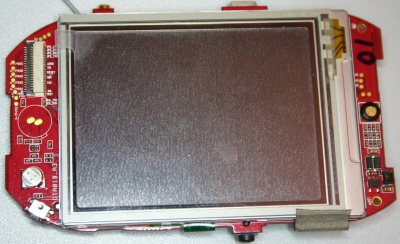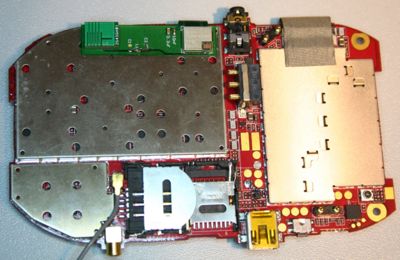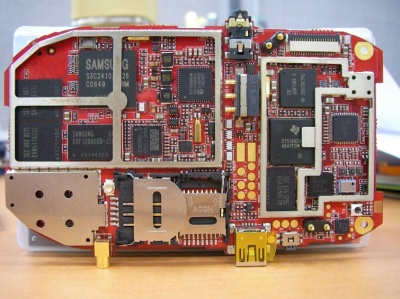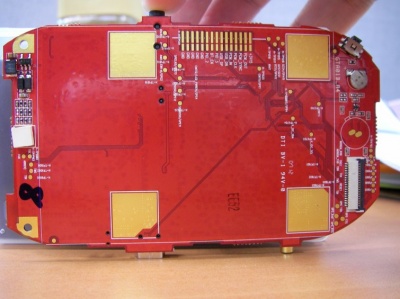Neo 1973 hardware
From Openmoko
m (removed the mentioning of android - useless there) |
(Exchg bootloader with U-Boot) |
||
| (11 intermediate revisions by 6 users not shown) | |||
| Line 1: | Line 1: | ||
| − | {{ | + | {{Neo1973}} |
| − | + | Openmoko is a software distribution stack that sits on top of a [[hardware]] platform. The [[Neo1973]] phone is the first hardware platform to take advantage of Openmoko. You can find specifics of the [[:Category:Neo1973 Hardware | Neo1973 Hardware]] by reviewing this introduction page and the pages in the category as shown at the bottom of this page. | |
'''Note that this page is about the first Openmoko phone which is now discontinued. See details on the second Openmoko phone at this page - [[Neo FreeRunner GTA02 Hardware]].''' | '''Note that this page is about the first Openmoko phone which is now discontinued. See details on the second Openmoko phone at this page - [[Neo FreeRunner GTA02 Hardware]].''' | ||
| Line 21: | Line 21: | ||
== Main components == | == Main components == | ||
| − | |||
| − | |||
| − | + | {| | |
| − | + | |- | |
| − | + | ! style="width:250px" | Component | |
| − | + | ! Chip or Info | |
| − | + | |- | |
| − | + | | ''' Main Components ''' | |
| − | + | | | |
| − | + | |- | |
| − | + | | Processor | |
| − | + | | [[Samsung S3C2410]] | |
| − | + | |- | |
| − | + | | NAND-Flash | |
| − | + | | 64MB into [[Samsung K9F1208U0B]] | |
| − | + | |- | |
| − | + | | SDRAM | |
| − | + | | 128MB from the 2 [[Samsung K4M511633C]] | |
| − | + | |- | |
| − | + | | [[GSM]]/[[GPRS]] | |
| − | + | | Texas Instruments Calypso based, probably [[TI Calypso D751992AZHH]] | |
| − | 128MB | + | |- |
| − | + | | [[GPS]]/[[AGPS]] | |
| − | + | | [[Hammerhead PMB 2520]]. | |
| − | + | |- | |
| − | + | | microSD-Card | |
| − | + | | Supported throught the [[Samsung_S3C2410]] | |
| − | + | |- | |
| − | + | | LCD | |
| − | + | | | |
| − | + | |- | |
| − | + | | LCD Module (LCM) | |
| − | + | | [[TPO TD028TTEC1]] module | |
| − | + | |- | |
| − | + | | style='vertical-align:top' | Touch Screen | |
| − | + | | More info, see [[TPO TD028TTEC1]] | |
| − | + | |- | |
| − | + | | Stylus | |
| − | + | | Seemingly identical to [http://cgi.ebay.com/4in1-PDA-Stylus-LED-Light-Torch-Laser-Pointer-Pen-h7_W0QQitemZ280089656134QQihZ018QQcategoryZ48677QQrdZ1QQcmdZViewItem this one on ebay] | |
| − | + | |- | |
| − | + | | Bluetooth | |
| − | + | | | |
| − | + | |- | |
| − | + | | Bluetooth module | |
| − | + | | [[Delta DFBM-CS320 Class2 Module]] | |
| − | + | |- | |
| − | + | | Bluetooth Headset | |
| − | + | | This one is wired via PCM bus from the CSR Bluetooth chip to the Wolfson codec. | |
| − | + | |- | |
| − | + | | style='vertical-align:top' | Vibrator | |
| − | + | | | |
| − | + | ||
| − | + | ||
| − | + | ||
| − | + | ||
| − | + | ||
| − | + | ||
| − | + | ||
| − | + | ||
| − | + | ||
| − | + | ||
| − | + | ||
| − | + | ||
| − | + | ||
| − | + | ||
| − | + | ||
| − | + | ||
| − | + | ||
| − | + | ||
| − | + | ||
| − | + | ||
| − | + | ||
| − | + | ||
| − | + | ||
| − | + | ||
| − | + | ||
| − | + | ||
| − | + | ||
| − | Seemingly identical to [http://cgi.ebay.com/4in1-PDA-Stylus-LED-Light-Torch-Laser-Pointer-Pen-h7_W0QQitemZ280089656134QQihZ018QQcategoryZ48677QQrdZ1QQcmdZViewItem this one on ebay] | + | |
| − | + | ||
| − | + | ||
| − | + | ||
| − | + | ||
| − | + | ||
| − | + | ||
| − | + | ||
| − | + | ||
| − | + | ||
| − | + | ||
| − | = | + | |
* Driver: https://svn.openmoko.org/trunk/src/target/kernel/patches/gta01-vibrator.patch | * Driver: https://svn.openmoko.org/trunk/src/target/kernel/patches/gta01-vibrator.patch | ||
* Connected to: S3C2410 GPIO | * Connected to: S3C2410 GPIO | ||
* Controllable via /sys/class/leds/gta01:vibrator | * Controllable via /sys/class/leds/gta01:vibrator | ||
| − | + | |- | |
| − | + | | USB Host | |
| − | + | | inside the [[Samsung S3C2410]] | |
| − | + | |- | |
| − | + | | USB Device | |
| − | + | | inside the [[Samsung S3C2410]] | |
| − | + | |- | |
| − | + | | style='vertical-align:top' | I2C Devices | |
| − | + | | The I2C is a simple communication standard intended to move small amounts of data a few inches between chips. | |
| − | + | ||
| − | + | ||
| − | + | ||
| − | + | ||
| − | + | ||
| − | The I2C is a simple communication standard intended to move small amounts of data a few inches between chips. | + | |
Please see [[I2C | Neo I2C Devices]] for more information & a list of devices & the addresses currently in use & documented for the Neo1973. | Please see [[I2C | Neo I2C Devices]] for more information & a list of devices & the addresses currently in use & documented for the Neo1973. | ||
| + | |- | ||
| + | | Audio | ||
| + | | See also: [[Neo1973 Audio Subsystem]] | ||
| + | |- | ||
| + | | Wolfson Codec | ||
| + | | [[WM8753]] | ||
| + | |- | ||
| + | | Stereo Amplifier | ||
| + | | [[LM4857]] | ||
| + | |- | ||
| + | | Analog wired Headset | ||
| + | | [[Analog wired Headset]] | ||
| + | |- | ||
| + | | [[Neo_1973_GTA01_Power_Management|Power Management]] | ||
| + | | [[Philips PCF50606]] | ||
| + | |- | ||
| + | | Battery | ||
| + | | [[Neo1973 Battery]] | ||
| + | |- | ||
| + | | style='vertical-align:top' | Buttons | ||
| + | | | ||
| + | * [[Neo1973 Power Button|The Power Button]] | ||
| + | * [[Neo1973 AUX Button|The "Aux" button]] | ||
| + | |- | ||
| + | | Case | ||
| + | | [[Neo1973 case schematics]] | ||
| + | |} | ||
| − | + | <!-- | |
| − | + | Todo for [[User:dolfje]] (please do not remove): | |
| + | * Add info of sdcard slot (=Transflash slot) | ||
| + | * Add info of the vibrators to a new wikipage | ||
| + | --> | ||
| − | + | == Alternate cases == | |
| − | + | ||
| − | + | ||
| − | + | ||
| − | + | ||
| − | + | ||
| − | + | ||
| − | + | ||
| − | + | ||
| − | + | ||
| − | + | ||
| − | + | ||
| − | + | ||
| − | + | ||
| − | + | ||
| − | + | ||
| − | + | ||
| − | + | ||
| − | + | ||
| − | + | ||
| − | + | ||
| − | + | ||
| − | + | ||
| − | + | ||
| − | + | ||
| − | + | ||
| − | + | ||
| − | + | ||
| − | + | ||
| − | + | ||
| − | + | ||
| − | + | ||
| − | + | ||
| − | + | ||
| − | + | ||
| − | + | ||
| − | + | ||
| − | + | ||
| − | + | ||
| − | + | ||
| − | + | ||
| − | + | ||
| − | + | ||
| − | + | ||
| − | + | ||
| − | + | ||
| − | + | ||
| − | + | ||
| − | + | ||
| − | + | ||
| − | + | ||
A number of alternate case designs have been suggested and requested. | A number of alternate case designs have been suggested and requested. | ||
| − | |||
| − | |||
| − | |||
[[Alternate Neo1973 case designs]] | [[Alternate Neo1973 case designs]] | ||
| − | == | + | == Hardware revisions== |
| − | + | {{Main|GTA01 revisions}} | |
| − | + | ||
| − | + | ||
| − | + | ||
| − | + | ||
| − | + | ||
| − | + | ||
| − | + | ||
| − | + | ||
| − | + | ||
| − | + | ||
| − | + | ||
| − | + | ||
| − | + | ||
| − | + | ||
| − | + | ||
| − | + | ||
| − | + | ||
| − | + | ||
| − | + | ||
| − | + | ||
| − | + | ||
| − | + | ||
| − | + | ||
| − | + | ||
| − | + | ||
| − | + | ||
| − | + | ||
| − | + | ||
| − | + | ||
| − | + | ||
| − | + | ||
| − | + | ||
| − | + | ||
| − | + | ||
| − | + | ||
| − | + | ||
| − | + | ||
| − | + | ||
| − | + | ||
| − | + | ||
| − | + | ||
| − | + | ||
| − | + | ||
| − | + | ||
| − | + | ||
| − | + | ||
| − | + | ||
| − | + | ||
| − | + | ||
| − | + | ||
| − | + | ||
| − | + | ||
| − | + | ||
| − | + | ||
| − | + | ||
| − | + | ||
| − | + | ||
| − | + | ||
| − | + | ||
| − | + | ||
| − | + | ||
| − | + | ||
| − | + | ||
| − | + | ||
| − | + | ||
| − | + | ||
| − | + | ||
| − | + | ||
| − | + | ||
| − | + | ||
| − | + | ||
| − | + | ||
| − | + | ||
===Debug Connector=== | ===Debug Connector=== | ||
| − | + | {{Main|Debug Board v2}} | |
| − | + | ||
| − | + | ||
| − | + | ||
| − | + | ||
| − | + | ||
| − | + | ||
| − | + | ||
| − | + | ||
| − | + | ||
| − | + | ||
| − | + | ||
| − | + | ||
| − | + | ||
| − | + | ||
| − | + | ||
| − | + | ||
| − | + | ||
| − | + | ||
| − | + | ||
| − | + | ||
| − | + | ||
===Test points=== | ===Test points=== | ||
| Line 300: | Line 136: | ||
== Distinguishing hardware revisions == | == Distinguishing hardware revisions == | ||
| − | === Inside the [[ | + | === Inside the [[U-Boot]] === |
| − | Every hardware revision has its own u-boot image type. Thus, the | + | Every hardware revision has its own u-boot image type. Thus, the U-Boot has the revision hard-coded. |
The hardware revision is passed on to the kernel via the ATAG mechanism (ATAG_REVISION) | The hardware revision is passed on to the kernel via the ATAG mechanism (ATAG_REVISION) | ||
| Line 333: | Line 169: | ||
[http://people.openmoko.org/tony_tu/GTA01/certificate/NCC/ NCC test report] | [http://people.openmoko.org/tony_tu/GTA01/certificate/NCC/ NCC test report] | ||
| − | |||
| − | |||
[[Category:Neo1973 Hardware]] | [[Category:Neo1973 Hardware]] | ||
Latest revision as of 10:25, 10 February 2012
| Neo 1973 |
|
sold out
|
|---|
Openmoko is a software distribution stack that sits on top of a hardware platform. The Neo1973 phone is the first hardware platform to take advantage of Openmoko. You can find specifics of the Neo1973 Hardware by reviewing this introduction page and the pages in the category as shown at the bottom of this page.
Note that this page is about the first Openmoko phone which is now discontinued. See details on the second Openmoko phone at this page - Neo FreeRunner GTA02 Hardware.
Contents |
[edit] User experiences of Phase 0 hardware
[edit] User reports of robustness
User experiences - drops onto concrete - ... Neo1973 Robustness
[edit] Physical Dimensions
- 120.7 x 62 x 18.5 mm (4.75 x 2.44 x 0.728 inch)
- 184 +/- 5 g (6.5 ounces)
- For the purposes of acquiring/cutting a properly sized screen protector, the display hole of the case is about 45 x 59 mm, while the top cover internal frame can house up to a 53 x 74 mm protector; sizes much larger than the display hole would obviously necessitate removing the front cover for installation.
- A Useful size comparison between the Neo1973, iPhone, Motorola A1200 and the SEM600i can be seen at sizeasy
[edit] Main components
| Component | Chip or Info |
|---|---|
| Main Components | |
| Processor | Samsung S3C2410 |
| NAND-Flash | 64MB into Samsung K9F1208U0B |
| SDRAM | 128MB from the 2 Samsung K4M511633C |
| GSM/GPRS | Texas Instruments Calypso based, probably TI Calypso D751992AZHH |
| GPS/AGPS | Hammerhead PMB 2520. |
| microSD-Card | Supported throught the Samsung_S3C2410 |
| LCD | |
| LCD Module (LCM) | TPO TD028TTEC1 module |
| Touch Screen | More info, see TPO TD028TTEC1 |
| Stylus | Seemingly identical to this one on ebay |
| Bluetooth | |
| Bluetooth module | Delta DFBM-CS320 Class2 Module |
| Bluetooth Headset | This one is wired via PCM bus from the CSR Bluetooth chip to the Wolfson codec. |
| Vibrator |
|
| USB Host | inside the Samsung S3C2410 |
| USB Device | inside the Samsung S3C2410 |
| I2C Devices | The I2C is a simple communication standard intended to move small amounts of data a few inches between chips.
Please see Neo I2C Devices for more information & a list of devices & the addresses currently in use & documented for the Neo1973. |
| Audio | See also: Neo1973 Audio Subsystem |
| Wolfson Codec | WM8753 |
| Stereo Amplifier | LM4857 |
| Analog wired Headset | Analog wired Headset |
| Power Management | Philips PCF50606 |
| Battery | Neo1973 Battery |
| Buttons | |
| Case | Neo1973 case schematics |
[edit] Alternate cases
A number of alternate case designs have been suggested and requested. Alternate Neo1973 case designs
[edit] Hardware revisions
- Main article: GTA01 revisions
[edit] Debug Connector
- Main article: Debug Board v2
[edit] Test points
- GSM RTS - H-TP1531
- GSM CTS - H-TP1530
- GSM Modem on - R10818 - ungrounded end
- GSM_EN - R1501 (not present) - ungrounded end
[edit] Distinguishing hardware revisions
[edit] Inside the U-Boot
Every hardware revision has its own u-boot image type. Thus, the U-Boot has the revision hard-coded. The hardware revision is passed on to the kernel via the ATAG mechanism (ATAG_REVISION)
[edit] Inside the Kernel
The kernel receives the ATAG_REVISION during bootup, and saves its contents in the "system_rev" global variable.
[edit] From Userspace
The kernel exports the system_rev variable in /proc/cpuinfo as "Revision :" line.
??? So does GTA01Bv4 equal the cat /proc/cpuinfo output of
Hardware : GTA01 Revision : 0240
[edit] Approval
- CE compliance is needed before a product can be sold in the EU. The CE mark indicates that a product complies to the relevant legislation, defined in the harmonised standards. This refers also to the most relevant, for the Neo1973, Directive 89/336/EEC on electromagnetic compatibility (EMC is the art of assuring electromagnetic compatibility between products). The standards are defined by CENELEC (European Committee for Electrotechnical Standardization), but not verified by any authority. It is the responsibilty of the manufacturer to convince himself that a product is in compliance, and is obligated to be able to prove this (with relevant technical documentation) for a specific product to the authorities on request. Whether the current Phase 1 devices are actually tested against the directives are unknown, no documentation has been disclosed, other than the fact that the devices bear the CE mark.
[edit] GTA01 FCC test report
[edit] GTA01 CE test report
[edit] GTA01 NCC test report
For Taiwan Import usage:




